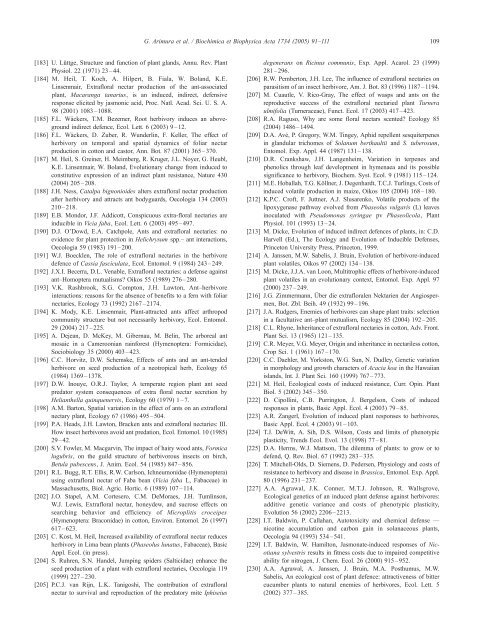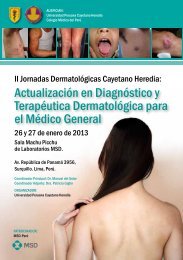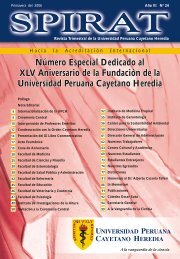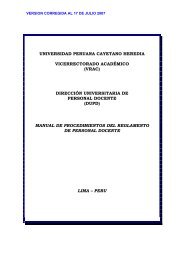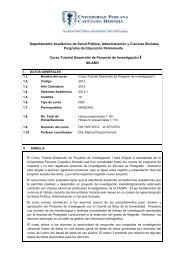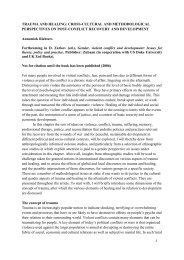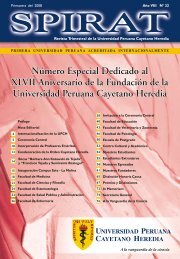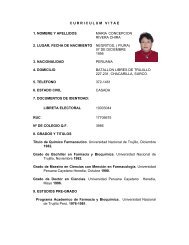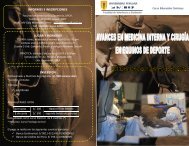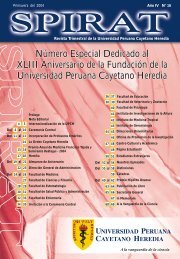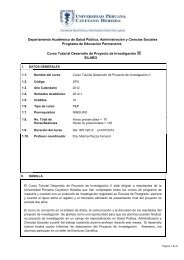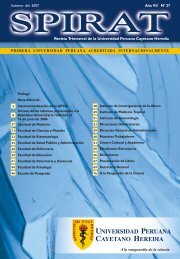Herbivore-induced, indirect plant defences - UPCH
Herbivore-induced, indirect plant defences - UPCH
Herbivore-induced, indirect plant defences - UPCH
You also want an ePaper? Increase the reach of your titles
YUMPU automatically turns print PDFs into web optimized ePapers that Google loves.
G. Arimura et al. / Biochimica et Biophysica Acta 1734 (2005) 91–111 109[183] U. Lqttge, Structure and function of <strong>plant</strong> glands, Annu. Rev. PlantPhysiol. 22 (1971) 23–44.[184] M. Heil, T. Koch, A. Hilpert, B. Fiala, W. Boland, K.E.Linsenmair, Extrafloral nectar production of the ant-associated<strong>plant</strong>, Macaranga tanarius, is an <strong>induced</strong>, <strong>indirect</strong>, defensiveresponse elicited by jasmonic acid, Proc. Natl. Acad. Sci. U. S. A.98 (2001) 1083–1088.[185] F.L. W7ckers, T.M. Bezemer, Root herbivory induces an aboveground<strong>indirect</strong> defence, Ecol. Lett. 6 (2003) 9–12.[186] F.L. W7ckers, D. Zuber, R. Wunderlin, F. Keller, The effect ofherbivory on temporal and spatial dynamics of foliar nectarproduction in cotton and castor, Ann. Bot. 87 (2001) 365–370.[187] M. Heil, S. Greiner, H. Meimberg, R. Kruger, J.L. Noyer, G. Heubl,K.E. Linsenmair, W. Boland, Evolutionary change from <strong>induced</strong> toconstitutive expression of an <strong>indirect</strong> <strong>plant</strong> resistance, Nature 430(2004) 205–208.[188] J.H. Ness, Catalpa bignonioides alters extrafloral nectar productionafter herbivory and attracts ant bodyguards, Oecologia 134 (2003)210–218.[189] E.B. Mondor, J.F. Addicott, Conspicuous extra-floral nectaries areinducible in Vicia faba, Ecol. Lett. 6 (2003) 495–497.[190] D.J. O’Dowd, E.A. Catchpole, Ants and extrafloral nectaries: noevidence for <strong>plant</strong> protection in Helichrysum spp.– ant interactions,Oecologia 59 (1983) 191–200.[191] W.J. Boecklen, The role of extrafloral nectaries in the herbivoredefence of Cassia fasciculata, Ecol. Entomol. 9 (1984) 243–249.[192] J.X.I. Becerra, D.L. Venable, Extrafloral nectaries: a defense againstant–Homoptera mutualisms? Oikos 55 (1989) 276–280.[193] V.K. Rashbrook, S.G. Compton, J.H. Lawton, Ant–herbivoreinteractions: reasons for the absence of benefits to a fern with foliarnectaries, Ecology 73 (1992) 2167–2174.[194] K. Mody, K.E. Linsenmair, Plant-attracted ants affect arthropodcommunity structure but not necessarily herbivory, Ecol. Entomol.29 (2004) 217–225.[195] A. Dejean, D. McKey, M. Gibernau, M. Belin, The arboreal antmosaic in a Cameroonian rainforest (Hymenoptera: Formicidae),Sociobiology 35 (2000) 403–423.[196] C.C. Horvitz, D.W. Schemske, Effects of ants and an ant-tendedherbivore on seed production of a neotropical herb, Ecology 65(1984) 1369–1378.[197] D.W. Inouye, O.R.J. Taylor, A temperate region <strong>plant</strong> ant seedpredator system consequences of extra floral nectar secretion byHelianthella quinquenervis, Ecology 60 (1979) 1–7.[198] A.M. Barton, Spatial variation in the effect of ants on an extrafloralnectary <strong>plant</strong>, Ecology 67 (1986) 495–504.[199] P.A. Heads, J.H. Lawton, Bracken ants and extrafloral nectaries: III.How insect herbivores avoid ant predation, Ecol. Entomol. 10 (1985)29–42.[200] S.V. Fowler, M. Macgarvin, The impact of hairy wood ants, Formicalugubris, on the guild structure of herbivorous insects on birch,Betula pubescens, J. Anim. Ecol. 54 (1985) 847–856.[201] R.L. Bugg, R.T. Ellis, R.W. Carlson, Ichneumonidae (Hymenoptera)using extrafloral nectar of Faba bean (Vicia faba L, Fabaceae) inMassachusetts, Biol. Agric. Hortic. 6 (1989) 107–114.[202] J.O. Stapel, A.M. Cortesero, C.M. DeMoraes, J.H. Tumlinson,W.J. Lewis, Extrafloral nectar, honeydew, and sucrose effects onsearching behavior and efficiency of Microplitis croceipes(Hymenoptera: Braconidae) in cotton, Environ. Entomol. 26 (1997)617–623.[203] C. Kost, M. Heil, Increased availability of extrafloral nectar reducesherbivory in Lima bean <strong>plant</strong>s (Phaseolus lunatus, Fabaceae), BasicAppl. Ecol. (in press).[204] S. Ruhren, S.N. Handel, Jumping spiders (Salticidae) enhance theseed production of a <strong>plant</strong> with extrafloral nectaries, Oecologia 119(1999) 227–230.[205] P.C.J. van Rijn, L.K. Tanigoshi, The contribution of extrafloralnectar to survival and reproduction of the predatory mite Iphiseiusdegenerans on Ricinus communis, Exp. Appl. Acarol. 23 (1999)281–296.[206] R.W. Pemberton, J.H. Lee, The influence of extrafloral nectaries onparasitism of an insect herbivore, Am. J. Bot. 83 (1996) 1187–1194.[207] M. Cuautle, V. Rico-Gray, The effect of wasps and ants on thereproductive success of the extrafloral nectaried <strong>plant</strong> Turneraulmifolia (Turneraceae), Funct. Ecol. 17 (2003) 417–423.[208] R.A. Raguso, Why are some floral nectars scented? Ecology 85(2004) 1486–1494.[209] D.A. Avé, P. Gregory, W.M. Tingey, Aphid repellent sesquiterpenesin glandular trichomes of Solanum berthaultii and S. tuberosum,Entomol. Exp. Appl. 44 (1987) 131–138.[210] D.R. Crankshaw, J.H. Langenheim, Variation in terpenes andphenolics through leaf development in hymenaea and its possiblesignificance to herbivory, Biochem. Syst. Ecol. 9 (1981) 115–124.[211] M.E. Hoballah, T.G. Köllner, J. Degenhardt, T.C.J. Turlings, Costs of<strong>induced</strong> volatile production in maize, Oikos 105 (2004) 168–180.[212] K.P.C. Croft, F. Juttner, A.J. Slusarenko, Volatile products of thelipoxygenase pathway evolved from Phaseolus vulgaris (L) leavesinoculated with Pseudomonas syringae pv Phaseolicola, PlantPhysiol. 101 (1993) 13–24.[213] M. Dicke, Evolution of <strong>induced</strong> <strong>indirect</strong> <strong>defences</strong> of <strong>plant</strong>s, in: C.D.Harvell (Ed.), The Ecology and Evolution of Inducible Defenses,Princeton University Press, Princeton, 1999.[214] A. Janssen, M.W. Sabelis, J. Bruin, Evolution of herbivore-<strong>induced</strong><strong>plant</strong> volatiles, Oikos 97 (2002) 134–138.[215] M. Dicke, J.J.A. van Loon, Multitrophic effects of herbivore-<strong>induced</strong><strong>plant</strong> volatiles in an evolutionary context, Entomol. Exp. Appl. 97(2000) 237–249.[216] J.G. Zimmermann, Über die extrafloralen Nektarien der Angiospermen,Bot. Zbl. Beih. 49 (1932) 99–196.[217] J.A. Rudgers, Enemies of herbivores can shape <strong>plant</strong> traits: selectionin a facultative ant–<strong>plant</strong> mutualism, Ecology 85 (2004) 192–205.[218] C.L. Rhyne, Inheritance of extrafloral nectaries in cotton, Adv. Front.Plant Sci. 13 (1965) 121–135.[219] C.R. Meyer, V.G. Meyer, Origin and inheritance in nectariless cotton,Crop Sci. 1 (1961) 167–170.[220] C.C. Daehler, M. Yorkston, W.G. Sun, N. Dudley, Genetic variationin morphology and growth characters of Acacia koa in the Hawaiianislands, Int. J. Plant Sci. 160 (1999) 767–773.[221] M. Heil, Ecological costs of <strong>induced</strong> resistance, Curr. Opin. PlantBiol. 5 (2002) 345–350.[222] D. Cipollini, C.B. Purrington, J. Bergelson, Costs of <strong>induced</strong>responses in <strong>plant</strong>s, Basic Appl. Ecol. 4 (2003) 79–85.[223] A.R. Zangerl, Evolution of <strong>induced</strong> <strong>plant</strong> responses to herbivores,Basic Appl. Ecol. 4 (2003) 91–103.[224] T.J. DeWitt, A. Sih, D.S. Wilson, Costs and limits of phenotypicplasticity, Trends Ecol. Evol. 13 (1998) 77–81.[225] D.A. Herms, W.J. Mattson, The dilemma of <strong>plant</strong>s: to grow or todefend, Q. Rev. Biol. 67 (1992) 283–335.[226] T. Mitchell-Olds, D. Siemens, D. Pedersen, Physiology and costs ofresistance to herbivory and disease in Brassica, Entomol. Exp. Appl.80 (1996) 231–237.[227] A.A. Agrawal, J.K. Conner, M.T.J. Johnson, R. Wallsgrove,Ecological genetics of an <strong>induced</strong> <strong>plant</strong> defense against herbivores:additive genetic variance and costs of phenotypic plasticity,Evolution 56 (2002) 2206–2213.[228] I.T. Baldwin, P. Callahan, Autotoxicity and chemical defense —nicotine accumulation and carbon gain in solanaceous <strong>plant</strong>s,Oecologia 94 (1993) 534–541.[229] I.T. Baldwin, W. Hamilton, Jasmonate-<strong>induced</strong> responses of Nicotianasylvestris results in fitness costs due to impaired competitiveability for nitrogen, J. Chem. Ecol. 26 (2000) 915–952.[230] A.A. Agrawal, A. Janssen, J. Bruin, M.A. Posthumus, M.W.Sabelis, An ecological cost of <strong>plant</strong> defence: attractiveness of bittercucumber <strong>plant</strong>s to natural enemies of herbivores, Ecol. Lett. 5(2002) 377–385.


